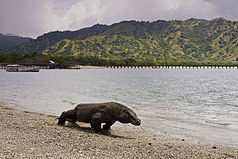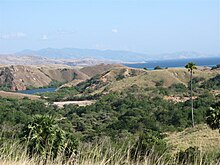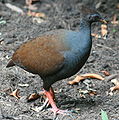Komodo National Park
| Komodo National Park | ||
|---|---|---|
| Komodo dragon ( Varanus komodoensis ) | ||
|
|
||
| Location: | Indonesia | |
| Surface: | 1817 km² | |
| Founding: | 1980 Indonesia, 1991 UNESCO | |
The Komodo National Park ( Indonesian Taman Nasional Komodo ) is located in Indonesia , in the area of the Lesser Sunda Islands in the border area of the provinces of East Nusa Tenggara and West Nusa Tenggara .
It includes the three larger islands Komodo , Rinca and Padar , as well as numerous smaller ones, with a total land area of 603 km², with a total area of the national park of 1817 km².
The park was established in 1980, originally only as a sanctuary for the Komodo dragon . Later it was dedicated to the preservation of all flora and fauna, including in the maritime area. The waters around the islands have 1,000 species of fish, 260 species of reef coral, 70 different sponges, 17 species of whales and dolphins, and two species of sea turtles. Since the beginning of the protective measures, dynamite fishing has been stopped and the area covered with corals has grown by 60 percent. The park is popular with divers because of its biodiversity .
The park's larger mammals are of Asian origin. The maned deer is the main prey of the Komodo dragon. There are also wild boars, crab monkeys, spotted musangs ( Paradoxurus hermaphroditus lehmanni ), water buffalos and horses. The endemic rat Rattus rintjanus is a specialty .
| Komodo National Park | |
|---|---|
|
UNESCO world heritage |
|
| National territory: | Indonesia |
| Type: | nature |
| Criteria : | (vii) (x) |
| Surface: | 219 322 ha |
| Reference No .: | 609 |
| UNESCO region : | Asia and Pacific |
| History of enrollment | |
| Enrollment: | 1991 (session 15) |
The islands of the national park are of volcanic origin. About 4,000 people live in its area in four settlements. In 1991 the national park was recognized by UNESCO as a World Heritage Site. The city of Labuan Bajo on Flores is the starting point for most travelers.
tourism
Komodo dragons are the main attraction for tourists in Komodo National Park. Within the Komodo National Park, 3,267 people currently live in four villages and 16,816 people live immediately around the park (as of 2007). Tourism began in the 1980s with the establishment of the national park, around 30,000 tourists were counted in 1995/96, 93% of them foreigners, mostly Dutch, German, English, US-Americans and Australians.
So far, Komodo has been developed almost exclusively for tourism and most guests make a day trip to the island as part of a vacation in Southeast Asia. In 1995/96, tourists spent an estimated US $ 1.1 million around Komodo National Park. It is criticized that only about 1% of this money goes to its residents - the majority of the sum is spent in the two places from which it can be reached: Labuan Bajo on Flores and Sape on Sumbawa . However, according to a 1996 survey, the majority of the population were inclined to tourism: 92.7% said they would be happy to see more tourists. However, voices were raised that tourism was damaging the Lesser Sunda Islands' culture and that products and services were becoming more expensive. 47.4% of the poor, on average, complained that only rich residents would benefit, and 27.3% said that their families would not benefit significantly from tourism.
The practice of attracting the Komodo dragons, which are difficult to observe, with slaughtered goats to special “viewing sites” for tourists is also controversial. Since the Komodo dragons are strongly bound to these places and occur in high concentrations, spatial behavior could be significantly influenced and intraspecific aggression could be favored, or the animals connect humans to food and attack them in anticipation of food. On the other hand, the sale of goats as bait for the local population brings in up to a third of their profit from tourism.
Komodo dragon approaches a maned deer
Individual evidence
- ↑ UNESCO World Heritage Center: Komodo National Park. Retrieved September 5, 2017 .
- ^ The official website of Komodo National Park, Indonesia. (No longer available online.) Archived from the original on September 6, 2017 ; Retrieved January 1, 2011 . Info: The archive link was inserted automatically and has not yet been checked. Please check the original and archive link according to the instructions and then remove this notice.
- ^ A b M. J. Walpole (2001): Feeding dragons in Komodo National Park: a tourism tool with conservation complications . Animal Conservation 4, pp. 67–73 ( full text ; PDF file; 293 kB)
- ^ MJ Walpole & HJ Goodwin (2000): Local economic impacts of dragon tourism in Indonesia . Annals of Tourism Research 27 (3), pp. 559–576 ( full text ; PDF; 137 kB)
- ^ MJ Walpole & HJ Goodwin (2001): Local attitudes towards conservation and tourism around Komodo National Park, Indonesia . Environmental Conservation 28 (2), pp. 160–166 ( full text ( memento of the original dated December 9, 2011 in the Internet Archive ) Info: The archive link was automatically inserted and not yet checked. Please check the original and archive link according to the instructions and then remove this notice. )
See also
Web links
- Entry on the UNESCO World Heritage Center website ( English and French ).
- Komodo National Park (Engl.)
- The Nature Conservancy - Coral Triangle Center
- Komodo Island












